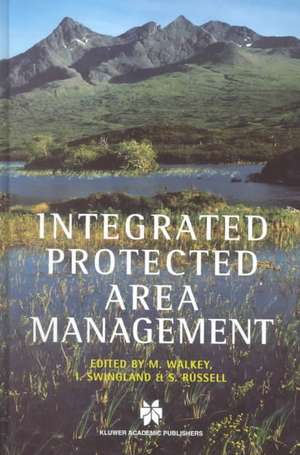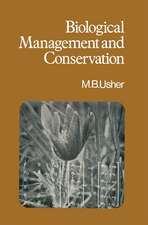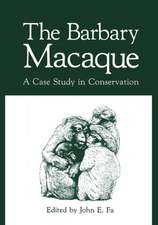Integrated Protected Area Management
Editat de Michael Walkey, Ian R. Swingland, Shaun Russellen Limba Engleză Hardback – 31 mai 1999
Integrated Protected Area Management features contributions that consider the design, management and sustainable use of these regions. Three principal aspects are considered:
- the theory and practice of designation
- community-based conservation and the concept of sustainability
- identifying priorities for management.
The emphasis throughout is on the importance of an interdisciplinary approach to planning and the active involvement of all stakeholders in decision-making processes as a means of ensuring long-term sustainability.
| Toate formatele și edițiile | Preț | Express |
|---|---|---|
| Paperback (1) | 945.62 lei 6-8 săpt. | |
| Springer Us – 31 oct 2012 | 945.62 lei 6-8 săpt. | |
| Hardback (1) | 951.91 lei 6-8 săpt. | |
| Springer Us – 31 mai 1999 | 951.91 lei 6-8 săpt. |
Preț: 951.91 lei
Preț vechi: 1160.86 lei
-18% Nou
Puncte Express: 1428
Preț estimativ în valută:
182.15€ • 190.57$ • 151.31£
182.15€ • 190.57$ • 151.31£
Carte tipărită la comandă
Livrare economică 02-16 aprilie
Preluare comenzi: 021 569.72.76
Specificații
ISBN-13: 9780412803604
ISBN-10: 0412803607
Pagini: 299
Ilustrații: XVIII, 299 p.
Dimensiuni: 155 x 235 x 19 mm
Greutate: 0.63 kg
Ediția:1999
Editura: Springer Us
Colecția Springer
Locul publicării:New York, NY, United States
ISBN-10: 0412803607
Pagini: 299
Ilustrații: XVIII, 299 p.
Dimensiuni: 155 x 235 x 19 mm
Greutate: 0.63 kg
Ediția:1999
Editura: Springer Us
Colecția Springer
Locul publicării:New York, NY, United States
Public țintă
ResearchCuprins
1 Protected areas in context.- 1.1 Introduction.- 1.2 The concept of the ‘protected area’.- 1.3 The significance of changing attitudes to nature.- 1.4 The diversity of protected areas.- 1.5 The UN List.- 1.6 Caracas: the problems and the challenges identified.- 1.7 The conclusions of Caracas.- 1.8 The economic valuation of protected areas.- 1.9 Protected areas in context.- 1.10 Protected areas and local people.- 1.11 Conclusions.- References.- 2 Designation of and management planning for protected areas.- 2.1 Ramsar sites and Special Protection Areas (SPAs).- 2.2 National Nature Reserves and Marine Nature Reserves.- 2.3 SSSIs in England.- 2.4 A new approach to SSSI management.- 2.5 Biodiversity Action Plans.- 2.6 Actions or initiatives taken by other organizations to aid the management planning of protected areas.- 2.7 Natural Areas.- 2.8 Natural Areas and wetlands.- 2.9 Sources of information.- 2.10 National overview.- 2.11 Wetland profiles.- 2.12 Conclusion.- Appendix 2A UK sites listed as wetlands of international importance under the Ramsar Convention.- Appendix 2B UK sites classified as Special Protection Areas under EC Birds Directive.- Appendix 2C Example Natural Area profiles.- Appendix 2D Assessment of wetland significance, by Natural Areas.- Appendix 2E NVC wetland communities and river types.- References.- 3 Conservation through development: the protected landscape approach.- 3.1 Protected landscape concept.- 3.2 Protected landscape approach in Britain.- 3.3 The way forward.- Appendix 3A Profile of the Snowdonia National Park.- 4 Links Between Population and Environment research programme: possible lessons for integrated protected area management.- 4.1 Introduction.- 4.2 General characteristics of the programme.- 4.3 General findings arising from researchunder the programme.- 4.4 Factors mediating the relationship between population and environment.- 4.5 Conclusion.- 4.6 Publications under this research programme.- 5 Identifying priorities for management of large mammals in Mkomazi Game Reserve, Tanzania.- 5.1 Introduction.- 5.2 Vegetation.- 5.3 Mammalian megafauna.- 5.4 Land use history.- 5.5 Management priorities.- 5.6 Prognosis.- References.- 6 Valuation and management of protected areas in Venezuela.- 6.1 Introduction.- 6.2 Methods.- 6.3 Results.- 6.4 Discussion.- Acknowledgements.- References.- 7 Commercialization, structure and sustainability of biodiversity conservation.- 7.1 Introduction.- 7.2 Definitions.- 7.3 Constraints and limits to sustainable development.- 7.4 Difficulties in determining criteria for assessing sustainability.- 7.5 Community biodiversity utilization projects.- 7.6 Conservation and sustainable bioresource use.- 7.8 Casebooks.- References.- 8 Aquatic biodiversity conservation in wetland and marine protected areas.- 8.1 Introduction.- 8.2 Establishment of wetland and marine protected areas.- 8.3 Threats to wetland and marine protected areas.- 8.4 Approaches to wetland and marine reserve management.- 8.5 Sustainable and multipurpose use.- 8.6 The future.- References.- 9 Modelling for sustainable forest use.- 9.1 Introduction.- 9.2 Global modelling.- 9.3 SARUM global model.- 9.4 Forestry model.- 9.5 Linking the models: land use.- 9.6 Illustrative simulations.- 9.7 Results.- 9.8 Conclusions.- Acknowledgements.- References.- 10 Conflict analysis and resolution.- 10.1 Introduction.- 10.2 Conflict: some paradigms.- 10.3 Conventional approaches to conflict.- 10.4 Alternative methods.- 10.5 Computer-based techniques.- 10.6 Metagame analysis.- 10.7 Conclusion.- References.- 11 From English moors and meadows to the Amazon rainforest: land use, biodiversity management and forgotten law.- 11.1 Introduction.- 11.2 Old English regulation of land use.- 11.3 Common rights — the wider implications for biodiversity management.- References.- 12 Aid for environment: the greening of development priorities.- 12.1 Introduction.- 12.2 Aid trends and the greening of development priorities.- 12.3 Multilateral agencies.- 12.4 Bilateral aid agencies.- 12.5 Discussion.- 12.6 Conclusion.- Acknowledgements.- References.- 13 Training: its importance and responsiveness to changing needs.- 13.1 Introduction.- 13.2 Basis of a training system.- 13.3 Areas for improvement of a training system.- 13.4 Present and future priorities for training.- 13.5 Conclusions.- References.- 14 Conclusions and prognosis.





